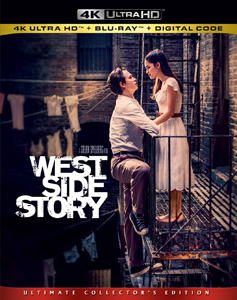“West Side Story” (2021), director Steven Spielberg’s adaptation of the 1957 stage musical, chronicles an ugly 20-block area of New York City fought over by Puerto Ricans and poor whites in the 1950s. The narrative reflects the ugly setting in a one-to-one ratio throughout. The gang members lead pathetic, joyless and blandly fatalistic lives, thus sapping the spirit out of even the cheerful song-and-dance numbers.
‘West Side’ bore-y
This incredibly long and slow film is dominated by unlikable characters, most personified by street brawler Riff (Mike Faist) of the Jets and amateur boxer Bernardo (David Alvarez) of the Sharks. They lead their gangs in an ongoing attempt to hold their territory.
It’s never clear if this neighborhood of slums and ruins is shared between the gangs in an uneasy truce, why the territory is important, why no one is willing to move to some other crappy area rather than die here, etc.
“West Side Story” (2021)
Director: Steven Spielberg
Writers: Tony Kushner (screenplay), Arthur Laurents (stage musical)
Stars: Ansel Elgort, Rachel Zegler, Ariana DeBose
“WSS” is supposed to be lump-in-your-throat tragic, but every event is easily avoidable. The plot turns are manipulated by temporarily peeved people. (“Revenge of the Sith’s” Emperor might’ve gotten his “Padme? She’s dead. You killed her” trick from this musical.) So rather than feeling sympathy for the inner-city poor of the 1950s, a viewer thinks about how stubborn and stupid everyone is.
Thrown against all this plight (the Griswolds would roll through this ’hood if they went on a time-travel vacation) is the star-crossed romance of Tony (Ansel Elgort) and Maria (Rachel Zegler). They fall in love because the screenplay (by Tony Kushner, working from the Arthur Laurents stage musical) says they do.
The actors’ chemistry is passable at best. It hurts that we’ve seen Elgort in superior and fresher romances such as “The Fault in Our Stars.” I suppose this is a prestige project, but I feel like he’s moved beyond roles in old musicals. Zegler is a pretty new face who will be worth following into better material.
Technically respectable
Unappealing viewing experience aside, “West Side Story” is competent on the technical side. The jailhouse number, “Gee, Officer Krupke,” in particular holds single shots for quite a while. The casting and costume design are on point: Everyone looks like 1950s gang members, and they can all dance and sing.
In a vacuum, “America” is good (and an earworm, for better or worse). I wonder if this number perhaps influenced Rammstein’s “Amerika” a half-century later; the Spanish and German-accented pronunciations of the word are similar. And while the Rammstein song is purposeful satire, some of that seeps into “WSS” too. Outside of the song, everything else tells us these Puerto Ricans won’t achieve their American dreams.

Here’s an oddity that’s probably not unique to Spielberg’s version: “WSS” is about violence, yet it’s also a musical. So we know we’re going to see stylized violence. Yet the mood suggests something profound. But it can’t be profound, because the production is so stylized. We never settle into accepting “WSS” as a tangible, real thing.
Same old ‘Story’
Spielberg’s film fails to transcend previous versions because it’s set on a huge stage, without much disguise. In a “Romeo and Juliet”-style sequence, Tony climbs the fire escape to Maria’s balcony. Spielberg shows off Elgort’s climbing skills, making an overlong scene longer, as if he’s a high school theater director showing off his stars and set (only multiply the budget and scale by a million).
Spielberg’s regular cinematographer, Janusz Kaminski, gives us moments of beauty through lighting and color tones, but the soundstage nature keeps everything artificial. Although you’ll see equally good stuff on, say, “The Marvelous Mrs. Maisel,” the dance choreography is briefly fun – see Anita’s (Ariana DeBose) swirling Spanish-style dress in the school-gym dance. (By the way, that scene suggests the Jets and Sharks are in high school! That doesn’t remotely ring true in the overall context.)
“WSS” is stolidly old-fashioned. This is certainly intentional; Spielberg was obviously on a Fifties nostalgia kick and made the film for his personal pleasure. But for a viewer who might be running through all the Oscar nominees – and seeing several with something fresh to say — “WSS” will leave them fruitlessly waiting to discover its reason for existing.
It doesn’t tease out 2020s meanings from the 1950s material (other than the blunt fact that racism and violence are timeless). What’s more, Spielberg keeps us monolingual folks at an artificial distance by not providing English subtitles when Spanish is spoken, the most ridiculous auteur flex since Zack Snyder released a square-shaped black-and-white “Justice League.”
“West Side Story” is exactly what you think it is, and nothing that you hope it would be.

